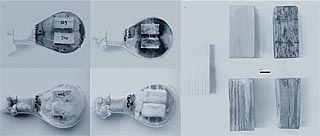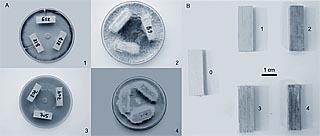
Edition 14 - November, 2003
 Edition 14 - November, 2003 |
Testing the suitability of microbial cultures for use as reference material in international norms and standardised methods |
According to national and international norms and standardised methods, accredited
or certified laboratories and companies active in fields related to microbiology
have to use well-determined strains of micro-organisms as references. However,
there are no criteria for checking the identity and the performances of these
reference strains by the strain provider. For that reason, BCCM/IHEM (biomedical
fungi and yeasts), BCCM/LMG (bacteria), and BCCM/MUCL (agro-industrial fungi
and yeasts), in cooperation with the Belgian accreditation body (Beltest) and
the Belgian Institute for Standardisation (BIN-IBN), established a project
to study the suitability of these microbial cultures. This project was financed
by the Belgian Federal Science Policy Office. The standardised methods and
correlated strains were selected in function of the specialisation of each
partner collection.
The aims were (i) to test the performances of the reference strains imposed
by the standards according to the standardised test methods and to compare
them with those of alternative strains, (ii) to test and propose potential
reference strains when standards did not specify strains, and (iii) to assess
the possibility of distributing the strains in a user-friendly form with properties
checked by means of standard operating procedures.
The BCCM/IHEM collection, which is specialised in medical fungi and yeasts,
selected three European and one French standard related to disinfectants and
antiseptics, each requiring two to four reference strains. In total, two fungal
strains and four yeasts were involved. The performances of these strains and
those of four other strains belonging to species particularly important in
hospitals were first studied following the procedure of the norm EN 1275 using
three commercial disinfectants. As the results were too dependant on the quality
of the commercial products chosen, it was decided to determine the sensitivities
of the strains to increasing concentrations of hypochlorite as the reference
disinfectant.
This showed that Aspergillus niger IHEM 3766, listed in most standards in that
field, has the same sensitivity than Aspergillus flavus IHEM 5903 but is more
resistant than Aspergillus fumigatus IHEM 10045, strains from two species more
important from a medical point of view. A. niger was also more resistant to
hypochlorite than Penicillium aurantiogriseum IHEM 18001, which is listed in
one French standard. A. niger IHEM 3766 is thus a suitable strain for testing
antiseptics or disinfectants.
Concerning yeasts, Candida albicans and Saccharomyces cerevisiae (two different
strains each), mandatory in standards, were compared to strains of C. tropicalis
and C. glabrata, species of growing importance in hospitals. C. tropicalis
IHEM 15905 was more resistant than the strains of the three other species,
indicating that it could be a good optional or additional reference strain
for norms concerning the use of antiseptics and disinfectants in hospitals.
Two of the strains studied and four bacterial strains tested by BCCM/LMG are
listed in methods from the European Pharmacopoeia. Their performance tests
were satisfactory.
BCCM/LMG selected 37 bacterial strains, currently available in freeze-dried
form from the public collection, to be checked for identity and performance
(as positive or negative control) according to 48 standardised methods used
in the food sector. For each strain, an experimental cell stock was prepared
in cryovials with 25 cryobeads and preserved at -20° C for 1-2 years in order
to simulate the sub-optimum preservation conditions used by the customer. The
performance tests carried out at the beginning and the end of the preservation
period were situated on three different levels: detection, enumeration and
confirmation. The tests were clustered in 16 groups: Bacillus cereus, Campylobacter,
Clostridium perfringens, Coliforms, Enterobacteriaceae, Enterococci, Escherichia
coli, Escherichia coli O157:H7, Lactic acid bacteria, Listeria, Pseudomonas,
Salmonella, Shigella, Staphylococcus aureus, Vibrio, Yersinia enterocolitica.
A total of 373 performance tests were carried out with the 37 selected reference
strains in relation to the 48 selected standards. Of these, 358 (96%) gave
results that conformed to those described in the standards. Consequently, 33
bacterial reference strains will be available in freeze-dried form with a certificate
of proven identity and performance. Storage for 1-2 years at -20° C on cryobeads
did not affect performance and maintained good viability for 26 of the 33 reference
strains.
BCCM/MUCL selected 20 fungal strains involved in wood degradation to check
their performance with respect to four European standards concerning wood preservation
products and to standard EN 113 in particular. Wood test specimens were exposed
to the strains for determining the mass loss that would allow the virulence
of the strains to be evaluated and the assays to be validated. The assay can
be accepted if the mean mass loss of the virulence control test specimens is
equal to or higher than the respective values for the minimum mass loss (20%
(m/m)). The following species of fungi were used: i) Coniophora puteana, Gloeophyllum
trabeum, Lentinus lepideus, Poria placenta and Serpula lacrymans on Scots pine
(brown-rot) and ii) Coriolus versicolor and Pleurotus ostreatus on beech (white-rot).
The virulence of the mandatory reference strains was compared to that of the
more recently isolated alternative strains. The virulence of these strains
was also determined by the screening test method. The principle of this method
is similar to the EN 113 method, except that smaller test pieces of wood are
used (30 x 10 x 5 mm as opposed to 50 x 25 x 15 mm) and that the exposure time
is shorter (6 weeks as opposed to 16).
 Fig. 1 EN 113 test. A, exposure to C. puteana MUCL 11662 (1), C. puteana MUCL 31046 (2), P. placenta MUCL 20569 (3), P. placenta MUCL 30789 (4); B, corresponding specimens of wood after 16 weeks of incubation (0 = control). |
 Fig. 2 Screening test. A, exposure to C. puteana MUCL 11662 (1), C. puteana MUCL 31046 (2), P. placenta MUCL 20569 (3), P. placenta MUCL 30789 (4); B, corresponding specimens of wood after 6 weeks of incubation (0 = control). |
Among the four mandatory reference strains tested, C. versicolor MUCL 11665
was the only one that had virulence greater than the minimum recommended in
the EN 113 standard and that showed reproducible results of virulence. Therefore,
alternative strains were tested under the EN 113 conditions. The virulence
of these alternative strains was greater than the minimum value established
in the standard, except for the strains of the species G. trabeum. The use
of alternative strains proved to be judicious. For example, the virulence of
the mandatory reference strain C. puteana MUCL 11662 was far under the 20%
limit while the alternative strain MUCL 31046 showed mean mass loss higher
than 30%. The alternative strain P. placenta MUCL 30789 was much more virulent
than the mandatory reference strain MUCL 20569
(Fig. 1). Compared to the EN 113 method, the screening test method was more
rapid (6 weeks instead of 16) and provided similar range of virulence (Fig.
2).
Each of the three collections has selected representative strains to assess
the form of supply on cryobeads at -20°C in order to meet the need of the clients
for strains in a user-friendly form. To test the viability, counts were performed
on 18 strains (2 from BCCM/IHEM, 7 from BCCM/LMG and 9 from BCCM/MUCL) during
a period of 14 to 18 months.
For most of the strains, the recovery from cryobeads was satisfactory. However,
the number of colony forming units recovered from different beads with the
same strain could vary considerably because of the non-standardized beads,
so a quantitative guarantee is not possible.
Twelve clients from BCCM/LMG and BCCM/MUCL agreed to test the strains on cryobeads
and to give their opinion in a detailed questionnaire; demonstrating that this
form of supply was highly appreciated.
Following this project, 26 out of the 33 BCCM/LMG reference strains will be
available with certificate as ready-to-use controlled working stocks in frozen
cryovials with 25 cryobeads, which can be preserved at -20°C during 1-2 years
at the user’s location.
Authors: Suzanne Heinemann, Tine Ryckoort, Véronique Simons
| Contact Tine Ryckoort Tel.: +32 (0)9 264 51 08 Fax: +32 (0)9 264 53 46 E-mail: tineke.ryckoort@UGent.be |
Home |
Contents Edition 14 - November, 2003 |